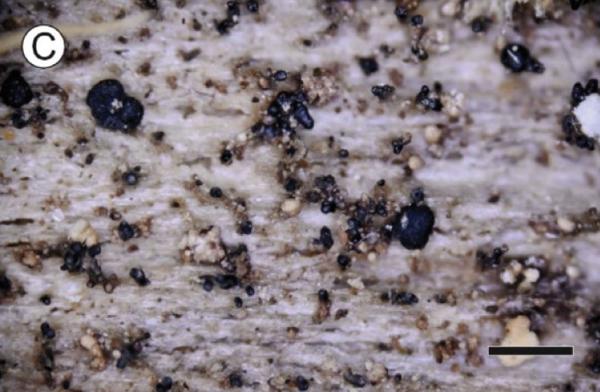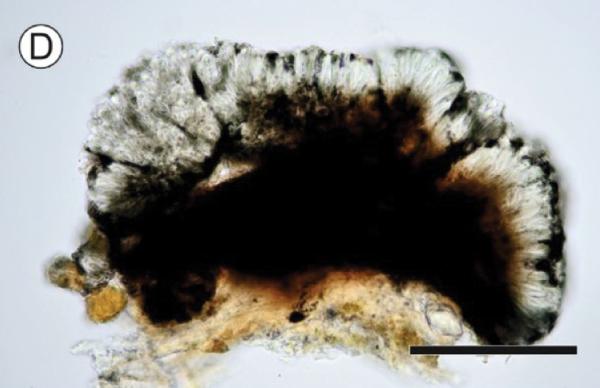Micarea melaeniza Hedl.
Bih. K. Svenska Vetensk. Akad. Handl., 3, 18, 3: 96, 1892
Synonyms:
Distribution:
Description: Thallus crustose, endosubstratic or episubstratic and then consisting of whitish, convex, 0.1-0.4 mm wide areoles, Apothecia micareoid, dull black, from the beginning convex-hemispherical to subglobose, (0.1-)0.2-0.3 mm across, often confluent into tuberculate, up to 0.5 mm wide aggregates, without a distinct proper margin. Proper exciple poorly developed, usually not evident; epithecium scarcely differentiated from the hymenium, irregularly pigmented, aeruginose green, or rarely sordid brown, sometimes with a purplish tinge, without crystals; hymenium aeruginose-green in upper and lower parts, colourless with vertical green streaks in middle part, the pigmented parts K+ olive-green (rarely K-), N+ red, (25-)28-42 µm high, without crystals; paraphyses of 2 types: a) evenly distributed, flexuose, branched, 0.7-1 µm thick, the apical cells sometimes pigmented and up to 2.5 µm wide; b) scattered or gathered in small fascicles, stout, c. 2 µm thick, coated by a greenish pigment; hypothecium dark brown, sometimes greenish or with a reddish tinge, often K+ olive-green in upper part (Cinereorufa-green pigment), N+ red, 120-200 µm high. Asci 8-spored, clavate to cylindrical-clavate, in K/I with a blue outer layer and apical dome and unstained wall, the dome with an apical cushion, 22-35 x 10-12 µm. Ascospores 1-celled, hyaline, ovoid or tear-shaped, 5-9 x 2.5-4 µm. Pycnidia numerous, black, 40-60 µm across, usually stalked, the stalks simple or rarely branched, bearing 1-4 pycnidia, the pycnidial wall dark olive green, the stalk tissue reddish brown, K-. Mesoconidia short-cylindrical, 2.3-3.6 x 1-3 µm. Photobiont micareoid, the cells 4-7 μm wide. Spot tests: thallus K-, C-, KC-, P-. Chemistry: thallus probably without lichen substances
Note: on lignum and conifer bark in boreal to temperate-montane forests; a very rare species, known also from the Eastern Alps (Austria); for futher details see Kantelinen & al. (2024). To be looked for in the Italian Alps.
Growth form: Crustose
Substrata: bark and lignum
Photobiont: green algae other than Trentepohlia
Reproductive strategy: mainly sexual

Predictive model

Source: Kantelinen A, Svensson M, Malíček J, Vondrák J, Thor G, Palice Z, Svoboda S, Myllys L (2024) A phylogenetic study of Micarea melaeniza and similar-looking species (Pilocarpaceae) unveils hidden diversity and clarifies species boundaries and reproduction modes. MycoKeys 106: 327-354. - CC BY-4.0
Micarea melaeniza (Holotype) C habit, apothecia and pycnidia D apothecial section in wate

Source: Kantelinen A, Svensson M, Malíček J, Vondrák J, Thor G, Palice Z, Svoboda S, Myllys L (2024) A phylogenetic study of Micarea melaeniza and similar-looking species (Pilocarpaceae) unveils hidden diversity and clarifies species boundaries and reproduction modes. MycoKeys 106: 327-354. - CC BY-4.0
Micarea melaeniza (Holotype) C habit, apothecia and pycnidia D apothecial section in wate
Growth form: Crustose
Substrata: bark and lignum
Photobiont: green algae other than Trentepohlia
Reproductive strategy: mainly sexual

Predictive model

Source: Kantelinen A, Svensson M, Malíček J, Vondrák J, Thor G, Palice Z, Svoboda S, Myllys L (2024) A phylogenetic study of Micarea melaeniza and similar-looking species (Pilocarpaceae) unveils hidden diversity and clarifies species boundaries and reproduction modes. MycoKeys 106: 327-354. - CC BY-4.0
Micarea melaeniza (Holotype) C habit, apothecia and pycnidia D apothecial section in wate

 INDEX FUNGORUM
INDEX FUNGORUM
 GBIF
GBIF

